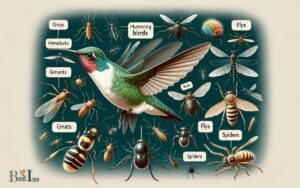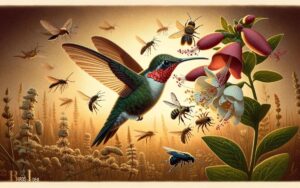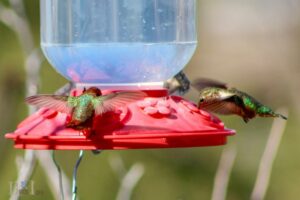Calliope Vs Anna’s Hummingbird: Comparison!
The Calliope Hummingbird (Selasphorus calliope) and Anna’s Hummingbird (Calypte anna) are often observed and compared by birdwatchers and researchers alike.
Both species share parts of their ranges and are known for their vibrant plumage and dynamic flight patterns.
However, they can be distinguished by differences in size, coloration, and behavior.
The Calliope Hummingbird is the smallest bird species in North America and has a distinct streaked throat pattern, while Anna’s Hummingbird is larger, with males displaying iridescent pink throats.
Both species play crucial roles in pollination and serve as indicators of environmental health.
The Calliope and Anna’s hummingbirds can be found in various parts of North America, with some overlap in their habitats, particularly in the western regions.
They exhibit unique behaviors:
Both species exhibit territorial behavior during breeding season and are adapted to a diet primarily consisting of nectar and insects.
Distinguishing between Calliope and Anna’s Hummingbirds enhances birdwatching experiences and aids in avian research and conservation.

Key Takeaway
9 Feature Analysis of Calliope and Anna’s Hummingbirds
| Feature | Calliope Hummingbird (Selasphorus calliope) | Anna’s Hummingbird (Calypte anna) |
|---|---|---|
| Size | About 3.1 to 3.5 inches in length | About 3.9 to 4.3 inches in length |
| Weight | Approximately 2 to 3 grams | Approximately 4 to 4.5 grams |
| Throat Coloration | Males: Streaked magenta throat | Males: Iridescent pink throat |
| Habitat | Mountainous regions, meadows, and forests | Coastal regions, chaparral, urban gardens |
| Distribution | Northwestern US, Canada, migrating to Mexico | Western North America, especially coastal and southern areas |
| Migration | Long-distance migrants | Often non-migratory, but some move to higher altitudes in summer |
| Nesting | Tiny cup nests on branches | Cup nests in trees or shrubs |
| Feeding Habits | Nectar from flowers, small insects, and spiders | Nectar, insects, and sugar-water from feeders |
| Conservation Status | Least Concern | Least Concern |
Size and Physical Appearance
Frequently, distinguishing between Calliope and Anna’s hummingbirds can be based on their size and physical appearance, which are crucial for accurate identification in the field.
Calliope hummingbirds are the smallest long-distance avian migrant in the world, measuring around 3 inches in length and weighing approximately 2-3 grams. They have a relatively short, straight, and thin bill.
In contrast, Anna’s hummingbirds are larger, about 4 inches in length, and weigh around 4 grams. They have a slightly longer and straighter bill compared to the Calliope hummingbird.
Additionally, Anna’s hummingbirds exhibit more iridescent pink and red coloration on their heads, especially the males, while Calliope hummingbirds display a vibrant purple patch on their throats, known as a gorget.
These distinct size and physical appearance characteristics aid in accurate field identification.
Habitat and Distribution
The Calliope hummingbird is primarily found in mountainous regions, favoring habitats with dense vegetation and coniferous trees.
In contrast, the Anna’s hummingbird has a widespread distribution, often thriving in urban and suburban areas, as well as coastal regions.
Understanding the distinct habitat preferences and distribution patterns of these two hummingbird species provides valuable insight into their ecological roles and potential interactions with human environments.
Calliope’s Mountain Habitats
Where does the Calliope hummingbird primarily inhabit in mountainous regions? Calliope hummingbirds primarily inhabit mountainous regions in Western North America, with a particular affinity for specific habitats within these regions.
Their distribution and habitat preferences are as follows:
- Subalpine Meadows: Calliope hummingbirds are often found in subalpine meadows characterized by an abundance of flowering plants such as lupine, paintbrush, and larkspur.
- Open Woodlands: They also inhabit open woodlands, particularly those with a diverse understory of flowering shrubs and small trees.
- Montane Riparian Areas: These hummingbirds are commonly seen in montane riparian areas, where they can find ample nectar from flowering plants along streams and rivers.
- Mountainous Chaparral: Calliope hummingbirds are known to frequent mountainous chaparral habitats, especially those with a profusion of flowering shrubs and small trees.
Their specific habitat preferences within mountainous regions contribute to their unique ecological niche.
Anna’s Widespread Urban Distribution
In urban areas, Anna’s Hummingbird is widely distributed and can be found in a variety of habitats. This species is highly adaptable and can thrive in diverse environments within cities, including parks, gardens, and residential areas.
Anna’s Hummingbirds are known to nest in a range of locations such as trees, shrubs, and even on human-made structures like wires and lamp posts. Their ability to inhabit urban landscapes has contributed to their increasing prevalence and visibility to people.
The availability of food sources, nesting opportunities, and suitable perching sites has facilitated their successful establishment in urban settings.
Understanding the distribution and habitat preferences of Anna’s Hummingbird in urban areas provides valuable insights into their ecological resilience and their interactions with human-altered environments.
This widespread urban distribution also influences the feeding behavior and diet of Anna’s Hummingbirds.
Feeding Behavior and Diet
Feeding behavior and diet significantly differ between Calliope and Anna’s hummingbirds, impacting their survival and reproductive success. These differences are crucial for understanding their ecological roles and interactions with their environment.
The following are key distinctions in their feeding behavior and diet:
- Feeding Behavior: Calliope hummingbirds primarily forage at lower heights, while Anna’s hummingbirds are known to feed at various levels, including higher altitudes.
- Nectar Sources: Calliope hummingbirds prefer to feed on flowers with tubular shapes, while Anna’s hummingbirds show a preference for flowers with more open shapes.
- Insect Consumption: Anna’s hummingbirds have been observed to consume a higher proportion of insects in their diet compared to Calliope hummingbirds.
- Territorial Feeding: Calliope hummingbirds are more likely to defend specific feeding territories, whereas Anna’s hummingbirds are known to be more flexible in their feeding habits.
Understanding these differences is essential for appreciating the distinct ecological niches and roles these hummingbirds occupy in their respective habitats. These differences also have implications for their vocalizations and sounds.
Vocalizations and Sounds
The vocalizations and sounds produced by Calliope and Anna’s hummingbirds play a crucial role in their communication and behavior.
Calliope hummingbirds are known for their distinctive high-pitched chirps, which are often used in territorial disputes and courtship displays.
On the other hand, Anna’s hummingbirds are recognized for the buzzing sounds produced by their rapid wingbeats, which are utilized in courtship rituals and territorial defense.
Understanding the differences in their vocalizations provides valuable insights into the unique communication strategies employed by these two hummingbird species.
Calliope’s High-Pitched Chirps
Calliope hummingbirds produce high-pitched chirps that are distinctive among hummingbird vocalizations. These chirps serve various purposes, including communication, territory defense, and courtship displays.
The high-pitched nature of these chirps allows them to travel efficiently through the dense vegetation of their forested habitats.
Calliope hummingbirds produce these sounds by rapidly flapping their wings and using specialized feathers to create the unique high-pitched tones.
The frequency and intensity of these chirps can convey information about the bird’s size, age, and even its emotional state.
Researchers have observed that these vocalizations play a crucial role in the social dynamics and breeding behaviors of Calliope hummingbirds, making them a key aspect of their ecological and evolutionary success.
Anna’s Buzzing Wing Sounds
Anna’s hummingbirds produce a distinctive buzzing sound with their wings, serving various functions such as territory defense and courtship displays.
The buzzing sound is created by the rapid flapping of their wings, which can beat at a rate of up to 80 times per second during courtship displays.
This sound is produced as a result of the aerodynamic forces and the air turbulence generated by the rapid wing movements. The frequency of the buzzing sound can also serve as a signal to communicate aggression or attraction to potential mates.
Additionally, the buzzing sound can act as a warning signal to other hummingbirds, indicating territorial boundaries. The unique buzzing wing sounds of Anna’s hummingbirds play a crucial role in their communication and social interactions within their environment.
Vocal Communication Differences
A comparison of the vocal communication differences, including vocalizations and sounds, between the Calliope and Anna’s hummingbirds reveals distinct patterns of acoustic signals used for various social interactions and environmental communication.
- Vocal Repertoire: Calliope hummingbirds produce complex songs with a mix of high-pitched buzzing and squeaky notes, while Anna’s hummingbirds are known for their sharp metallic chips and buzzy calls.
- Territorial Defense: Calliope males emit high-pitched chips during aggressive encounters, whereas Anna’s males produce a series of metallic “chip” notes when defending their territory.
- Mating Displays: Calliope males create complex songs with rapid trills during courtship, in contrast to Anna’s males, which perform aerial dives accompanied by loud wing trills.
- Environmental Signals: Both species use vocalizations to communicate with conspecifics and respond to environmental cues, but the specific sounds and their meanings vary between Calliope and Anna’s hummingbirds.
Courtship and Mating Rituals
During courtship and mating rituals, both the Calliope and Anna’s hummingbirds display intricate and captivating behaviors to attract potential mates and establish their breeding territories.
The Calliope hummingbird, for instance, performs an impressive U-shaped dive display, emitting a high-pitched buzzing sound as it ascends, followed by a steep descent to attract females and deter rival males.
Anna’s hummingbird, on the other hand, showcases an elaborate aerial display, involving steep dives and high-speed chirping to impress females and defend its territory from other males.
These courtship displays are crucial in the selection of mates and the establishment of breeding territories.
Understanding these behaviors provides valuable insights into the reproductive strategies of these fascinating birds.
Nesting Habits and Reproduction
The nesting habits and reproduction of both the Calliope and Anna’s hummingbirds are characterized by distinct strategies and behaviors that contribute significantly to their breeding success.
Nesting Behavior:
- Calliope Hummingbird: They build their nests on coniferous trees, often selecting locations near water sources.
- Anna’s Hummingbird: They construct their nests using plant fibers, down, and spider silk, typically in trees or shrubs.
Nesting Materials:
- Calliope Hummingbird: They use plant down, moss, and lichens for nest construction.
- Anna’s Hummingbird: They incorporate feathers, leaves, and other soft materials into their nests.
Reproductive Cycle:
- Calliope Hummingbird: Females lay 2 eggs and incubate them for about 16 days.
- Anna’s Hummingbird: Females lay 2 eggs and incubate them for approximately 14-19 days.
Nesting Site Selection:
- Calliope Hummingbird: They prefer higher elevations, nesting up to 10,000 feet.
- Anna’s Hummingbird: They often choose urban or suburban areas for nesting, displaying adaptability to human environments.
Migration Patterns
When do Calliope and Anna’s hummingbirds begin their migration?
Calliope hummingbirds typically start their migration in late July or early August, traveling from their breeding grounds in the western United States and Canada to their wintering grounds in Mexico and Central America.
On the other hand, Anna’s hummingbirds are non-migratory in many regions but may exhibit some migration in response to food availability and temperature changes.
In the table below, we compare the migration patterns of these two hummingbird species:
| Aspect | Calliope Hummingbird | Anna’s Hummingbird |
|---|---|---|
| Typical Migration Time | Late July or early August | Variable, in response to food and temperature changes |
| Migration Distance | Long-distance, from western US/Canada to Mexico/Central America | Short-distance, within their local range |
Understanding the migration patterns of these hummingbirds is crucial for conservation efforts and for appreciating their remarkable ability to adapt to changing environments.
Threats and Predators
In the presence of numerous threats and predators, Calliope and Anna’s hummingbirds must navigate their environments with caution and resilience.
These diminutive birds face a range of challenges that shape their behavior and survival strategies:
- Predatory Birds: Both Calliope and Anna’s hummingbirds are at risk of predation by larger birds such as hawks, falcons, and shrikes.
- Nest Predators: Their small, delicate nests are vulnerable to predation by snakes, squirrels, and other small mammals.
- Insect Predators: Hummingbirds are also susceptible to attacks from predatory insects such as praying mantises and spiders.
- Human-Induced Threats: Urbanization, habitat destruction, and pesticide use pose significant threats to the survival of these hummingbird species.
Despite these challenges, Calliope and Anna’s hummingbirds have developed adaptive behaviors to mitigate these threats and ensure their continued existence in their respective habitats.
Conservation Status
Both Calliope and Anna’s hummingbirds are classified as species of least concern by the International Union for Conservation of Nature (IUCN).
This classification indicates that these species are widespread and abundant, with stable populations.
The Calliope hummingbird’s range extends from western North America to western Mexico, while the Anna’s hummingbird is primarily found along the western coast of North America.
Their adaptable nature and ability to thrive in urban and suburban environments have contributed to their stable populations.
However, ongoing monitoring is essential to assess potential threats such as habitat loss, climate change, and disease outbreaks.
Conservation efforts should focus on preserving their natural habitats, ensuring the availability of suitable nectar sources, and minimizing potential hazards such as pesticide exposure.
Continued research and conservation initiatives are crucial to maintaining the least concern status of these remarkable hummingbird species.
Conclusion
The calliope and Anna’s hummingbirds differ in size, physical appearance, habitat, feeding behavior, vocalizations, courtship rituals, nesting habits, migration patterns, and threats from predators.
Both species have unique characteristics that make them fascinating subjects for study and observation. How might these differences impact their survival and ability to thrive in their respective environments?






